#Danielle Mouzon
Explore tagged Tumblr posts
Photo








#screenshots#mine#the wire#s2#s2e9#no caption#the greek#beadie#bodie#mcnulty#daniels#pearlman#brianna#stringer#brother mouzone#close up
6 notes
·
View notes
Video
youtube
Alphonse Mouzon Band – Just Because Of You
Alphonse Mouzon Band – Back To Jazz. Alto Saxophone – Doug Norwine. Bass – Welton Gite. Drums, Electronic Drums, Percussion, Trumpet, Synthesizer – Alphonse Mouzon. Piano Acoustic, Synthesizer – Jeff Daniel.
6 notes
·
View notes
Text
The Wire Season3 Episode10
The Wire Season3 Episode10
“Call it a crisis of leadership.” — Proposition Joe Brother Mouzone returns to Baltimore on a mission of revenge and casts a wide net in his search for Omar, who has his own plan. Colvin manages, for now, to put off a ‘Sun’ reporter inquiring about Amsterdam. Carver learns how much he doesn’t know about good policing, while Pearlman and Daniels plead their case for a new kind of wiretap to Judge…
View On WordPress
0 notes
Text
The Wire: 10 Storylines That Were Never Resolved | ScreenRant
Though it wasn't the most wildly watched show when it was on the air, The Wire has steadily risen in popularity to become one of the most acclaimed shows of all time. The HBO series explored the war on drugs within the streets of Baltimore and how it penetrated various aspects of the city.
RELATED: The Wire: Top 10 Characters, Ranked
The series was a realistic portrait of the modern crime world, and unlike most cop shows on television, it showed there was good and bad on both sides of the law. Though the series came to a satisfying end after five seasons, there were several questions left hanging. Here are 10 unresolved storylines from The Wire.
10 Daniels' Dark Past

Cedric Daniels was one of the more noble figures in the series. A veteran law enforcement officer, Daniels starts the series with ambitions to rise through the ranks but ultimately decides to put the Avon Barksdale case ahead of his own career ambitions.
As a way to convince Daniels to play ball, Burrell explains that he has a DEA file on Daniels that questions some unexplained income. Daniels seems to confirm that he did do something wrong, but it is never explained what his crimes were.
9 Brother Mouzone

One of the most fascinating characters on the show was a well-known figure from New York named Brother Mouzone. The calm and collected gentleman might not appear to be a threat, but his reputation is one that is feared by many.
RELATED: The Wire: Omar Little’s 10 Most Intimidating Quotes
Avon recruits Mouzone to help him rid Marlo Stanfield's crew from his territory. After being betrayed by Stringer Bell, Mouzone teams with Omar Little to take out Bell. Once he and Omar part ways, Brother Mouzone is never seen or heard from again.
8 The Greek

In Season 2, a new player in the drug world is introduced in the form of the mysterious "Greek". An apparent expert at keeping a low profile and avoiding police suspicion, The Greek operates as the supplier for several of Baltimore's biggest drug dealers.
By the end of Season 2, The Greek's operation has been found out and he leaves the country with his crew. However, we see in subsequent seasons that he is back working the same trade in Baltimore. We never discover how he managed to come back and remain anonymous.
7 Cheese And Randy

In one of the more random bits of trivia on the show, the creators revealed that Cheese Wagstaff and Randy Wagstaff are father and son. Cheese operates as a soldier for Proposition Joe, then Marlo. Randy is a young kid whose life is destroyed when rumors spread that he was snitching.
By the end of the series, Cheese is killed and Randy is living in a foster home, turned into an aggressive and violent young man. We never see the two speak to each other or even mention the other's existence.
6 Templeton's Lies

Season 5 of The Wire focuses on the fledgling newspaper industry in Baltimore. When news of a possible serial killer emerges, the paper's head people jump on the sensational story and assign young reporter Scott Templeton to cover various stories on the subject.
RELATED: The Wire: 15 Moments That Prove It's The Best TV Show Of All Time
It is later discovered that Templeton has fabricated most of his articles and is a fraud. Though his editor suspects the misdeeds and McNulty is aware he's phony, Templeton is later seen winning an award for his work. We never get to see if his lies eventually catch up with him.
5 Marlo's Path

Once Avon Barksdale is sent to prison, a new player moves in to take over. Marlo Stanfield is a cold and calculating man who is willing to drop as many bodies as he needs to in order to rule the Baltimore drug trade.
The final season sees McNulty and his team going after Marlo. While his empire falls, he is able to escape prosecution along with his wealth. The final episode finds him attempting to move into legitimate business but he also feels the need to return to his more dangerous life of crime. It's not clear which path he ultimately chooses.
4 Nicky Sobotka

Season 2 of the show focused on the troubled business at the Baltimore waterfront. The once-thriving port is struggling and Frank Sobotka, the man in charge of the docks, turns to drug trafficking to support his workers.
After Frank is killed by The Greek, his nephew Nicky decides to help out Daniels' investigation. He informs on the entire operation, forcing The Greek to leave his business behind. Nicky is placed in witness protection, but he is later seen on the docks not keeping a low profile at all. We never find out if he is still in witness protection or if he is now in danger.
3 Rawls' Secret

William Rawls is one of the most despicable characters on The Wire and he works for the police department. He is a racist and abusive man who only cares about bringing murder numbers down, regardless of how it is achieved.
RELATED: 5 Things The Sopranos Did Better Than The Wire (And 5 The Wire Did Better)
Despite his often-homophobic comments, Rawls is briefly seen in a gay bar in one episode. No mention is made of this and the subject of his sexuality never comes up. Though it would be nice to explore more, it was a great twist for the character.
2 Avon's Empire

Avon Barksdale was once the king of Baltimore's drug trade before he was pushed out by the young and ambitious Marlo and ultimately arrested. Later on in the series, we see Marlo visit prison to connect with a drug supplier, but comes face-to-face with Avon, who is running things in prison.
It is not clear how Avon has remained so powerful even when out of the drug game, but he is not someone to let his position of power go easily. It would have been interesting to see what he is up to from behind bars.
1 McNulty's Next Move

Jimmy McNulty is possibly the main character of the series and one of its most complicated. Though a very good detective, other aspects of McNulty's life seem to be a complete disaster. He is a severe alcoholic who cheats on women and has a self-destructive personality.
Though he briefly cleaned himself up with a new girlfriend Beadie, he soon slid back to his old ways. After the scandal with his fake serial killer, McNulty is fired. Knowing what a mess his life can become when he is not a cop, it's left open whether he'll change his ways or continue his downward spiral.
NEXT: The 25 Best HBO Original Series, Ranked
source https://screenrant.com/hbo-wire-show-storylines-never-resolved/
0 notes
Photo
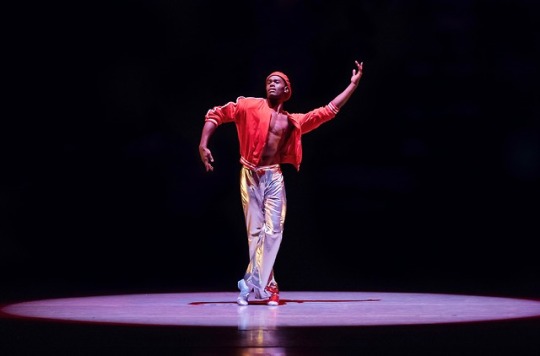
DANCE / 2017-2018
Alvin Ailey American Dance Theater
MINI PERFORMANCE
Robert Battle, Artistic Director Masazumi Chaya, Associate Artistic Director
So, What’s Going On?
You may have heard of Alvin Ailey American Dance Theater (AADT). No surprise—they’ve been on the main dance stage since 1958. Based in New York City, the company has toured all over the world, but who exactly was Alvin Ailey?
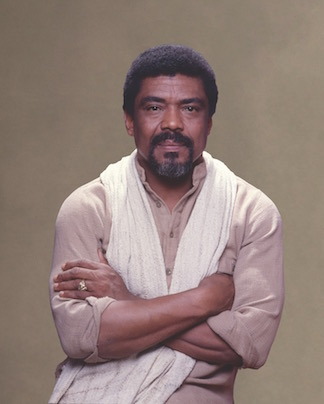
Portrait of Alvin Ailey by Jack Mitchell
Born in a small Texas town in 1931, Alvin Ailey began his dance training at age 11 by being exposed to classical, social, and folk dances, as well as the emerging style of modern dance. But at the start of his career, he encountered few opportunities for African American dancers like himself.
Ailey wanted to create a company that allowed African American dancers to display their talents and to express their experiences and heritage. When he formed AAADT, it was one of the first professional companies where dancers of all races and backgrounds were welcome. According to the New York Times, “You didn’t need to have known Alvin personally to be touched by his humanity, enthusiasm, and exuberance and his courageous stand for multicultural brotherhood.”
Watch (and learn) what makes Ailey “Ailey.”
youtube
Ailey died in 1989, but his legacy lives on with his company and school. Today, AAADT is under the artistic direction of Robert Battle who not only choreographs new works, but who also invites others to create dances for the company.
What is the Big Deal about Revelations?
Revelations is Alvin Ailey’s signature work and has been performed by the company since its creation in 1960. This masterwork has been seen by more people than any other modern dance. More than 25 million audience members in 71 countries have been to a performance. Now it’s your turn.
First, watch this short film that celebrates the work by telling the history and significance of this modern dance classic.
vimeo
It’s hard to watch Revelations and not be caught up in the emotions and atmosphere of the work. The dance is based on Ailey’s early years worshipping at his southern Baptist church. Drawing on his childhood recollections of people and places, and using traditional African American blues, work songs, and spirituals as his musical inspiration, Ailey tells the story of African American faith and persistence in the face of adversity.
Revelations is divided into three sections; each includes several dances representing different aspects or experiences in Baptist worship. The main sections include:

“Pilgrim of Sorrow” speaks of people yearning for salvation but burdened by the troubles of this life. Look for arms reaching out in all directions, and bodies pulled back to earth. PHOTO by Pierre Wachholder | Alvin Ailey American Dance Theater’s Ghari DeVore and Yannick Lebrun in Alvin Ailey’s Revelations
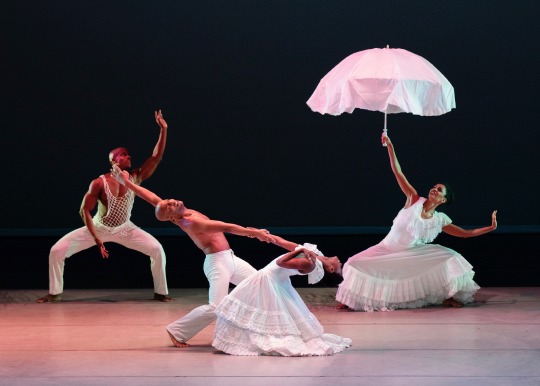
“Take Me to the Water” is an enactment of Ailey’s own baptism that took place in a pond behind his church. Watch for the devotional leader in white holding a large white umbrella. She leads a young couple to the baptismal river of billowing blue silk. Look for the way the dancers undulate through their arms and torsos and stretch long pieces of fabric to emulate rippling water. PHOTO by Paul Kolnik | AAADT’s C. Heyward, V. Gilmore, R. McLaren, F. Tesfagiorgis in Alvin Ailey’s Revelations

“Move, Members, Move” begins with a trio for three men to the song “Sinner Man.” The next section shows a congregation, decked out in yellow, participating in a joyous church service. Watch how Ailey brings humor to the work by showing churchgoers who gossip and others who fan themselves in the heat. PHOTO by Pierre Wachholder | Alvin Ailey American Dance Theater in Alvin Ailey’s Revelations
Ailey described the memories that inspired Revelations as “blood memories” because they were so strong he felt they were part of him as much as the blood that ran through his veins.
Another dance the company will perform is Stack-Up. Read on to learn more.
Step Back in Time for Stack-Up
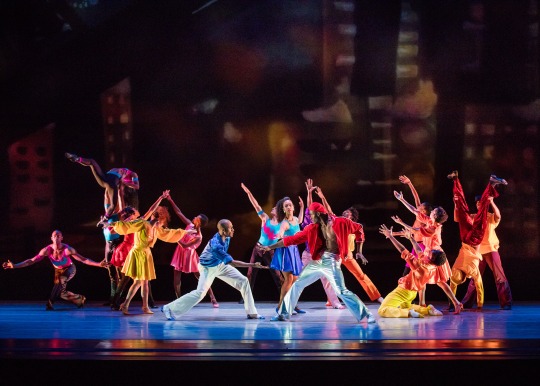
Alvin Ailey American Dance Theater in Talley Beatty's Stack-Up. Photo by Paul Kolnik.
Stack-Up Original Choreography by Talley Beatty (1982) Restaging by Masazumi Chaya Music by Earth, Wind & Fire; David Gates; Grover Washington, Jr.; Fearless Four; and Alphonse Mouzon
Look and listen as the music and costumes for Stack-Up transport us back to another time…the ‘80s to be exact, when Talley Beatty first choreographed this dance. And yet here we are, more than 35 years later, with so many of its themes still relevant today.
Stack-Up was inspired by the jammed freeways and gridlocked traffic of Los Angeles, where Beatty’s tense, chaotic dance dramas play out against a gritty cityscape. But this is about a different kind of traffic—about the pileups and backups between people living “stacked on top each other” in a tight, urban space.
In this three-part dance suite, we meet all kinds of city dwellers—from a young couple in love, to some community gang members, to others just out to have a good time. Each group is interested in “going about their business,” but are threatened by the menacing presence of the drug dealer as he looks for ways to take advantage of those around him.
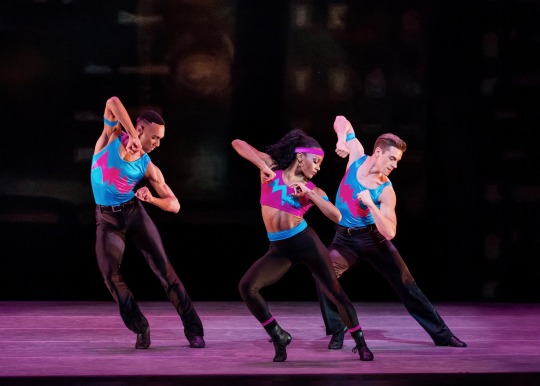
AAADT's Sean Carmon, Jaquelin Harris, and Michael McBride in Talley Beatty's Stack-Up. Photo by Paul Kolnik.
Watch for:
the lightning symbol worn by one group symbolizing their membership in a gang.
the moment when a young man, despite attempts by his girlfriend to stop him, decides to take some drugs from the dealer.
the way the movement and behavior of the young man changes under the influence of drugs.
break dancing, cartwheels, and back flips.
See Alvin Ailey’s dancers in Stack-Up:
youtube
Who was Talley Beatty?
Talley Beatty was an African American choreographer who lived from 1918-1995. Like Alvin Ailey, Beatty encountered challenges as a black man who wanted to study dance. In fact, he was forced to take ballet classes either very early in the morning or very late at night, and in dressing rooms instead of studios where white dancers studied.
Despite these difficulties, Beatty made a name for himself as a performer and choreographer. He danced with African American choreographer Katherine Dunham who was interested in movement from the Caribbean and Africa. Beatty also danced with Martha Graham, a choreographer who advanced modern dance in the United States.
Beatty’s style is a mixture of ballet and jazz; his work has been described as “fast and explosive,” and focused on the everyday life and struggles of African Americans.
Alvin Ailey American Dance Theater presents Stack-Up to celebrate 100 years since Beatty’s birth.
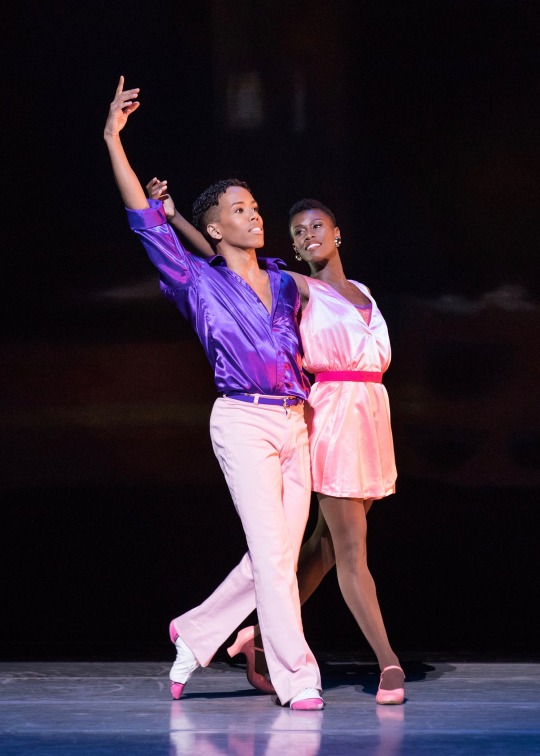
AAADT's Daniel Harder and Rachael McLaren in Talley Beatty's Stack-Up. Photo by Paul Kolnik.
To sample some of Talley Beatty’s other work, check out:
Mourner’s Bench (1947, Beatty’s signature solo work)
youtube
Alvin Ailey American Dance Theater’s Hope Boykin and choreographer and dancer Duane Cyrus discuss working with Talley Beatty at:
youtube
Check this out: Ailey’s Signature Style
Ailey accepted dancers into his company who were trained in different styles including ballet, modern, jazz, and hip hop. He encouraged their individual strengths and differences in style, bringing them together in performance like a conductor of jazz music. Despite these differences, there are common elements in his choreography. Watch for:
straight lines in the lower body, with quick and sharp leg and foot movements, like in ballet
an expressive upper body with fluid arms and torso movements, like in modern dance
energetic dancing that emphasizes strength
expressive hands
a fusion of African-influenced movements with ballet and modern dance
There is also good reason why Alvin Ailey called his company “a dance theater.” Ailey was interested in how elements of theater—costumes, props, lighting, and music—could be combined with dance to communicate with an audience. Watch…
how colors have meanings in costumes. Notice how the color scheme for the costumes is different in each section, first earth-toned, then white, and finally yellow. Why do you think he chose these colors?
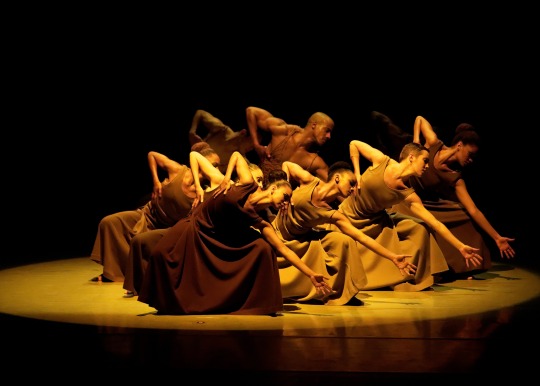
PHOTO by Pierre Wachholder | Alvin Ailey American Dance Theater in Alvin Ailey’s Revelations
how props tell a story. In Revelations, the dancers use props to help bring Ailey’s childhood memories to life. For example, long sheets of blue and white fabric stretched across the stage to suggest water; white parasols, wide-brimmed hats, and fans to imply the heat of Texas summers; and stools used by the dancers to represent a seated church congregation.
how lighting creates mood. Revelations begins with a group of dancers standing under a single spotlight on a darkened stage. Later, the dancers move across a fully illuminated stage. Why do you think the lighting changes?
Think About This: Different Ways of Working
Ever wonder how long it takes to choreograph a dance? Kyle Abraham, who created the work Untitled America for the Ailey company, spent two years on his three-part dance. But his process was in and out of the studio over months. Abraham held focused sessions with the dancers of two or three weeks at a time with long breaks in between. During those breaks, he thought about how he wanted to put the piece together before trying the movement with the dancers.
Choreographer Mauro Bigonzetti created Deep in a different way. Bigonzetti never plans out the movements before entering the studio. Instead, he studies how each individual dancer moves, and what their personality is like. His choreography depends on the strengths and style of the individual dancers.
Two different choreographers. Two different styles. If you were a dancer, would you want the choreographer to include you in the creative process, or tell you exactly what steps you needed to do?
Take Action: Art for All…
Alvin Ailey made Revelations based on his own personal experience, yet it speaks to people of all ages, all over the world, regardless of their racial and religious backgrounds. After you see the work, brainstorm why you think it inspires so many people every time it is performed.
Share your thoughts on Facebook, Instagram, Twitter, Tumblr, Snapchat, or any platform of your choice. Use #artforall as your hashtag.
Explore More
Go even deeper with the Ailey Performance Extras.
–
PHOTO (top) AAADT's Jamar Roberts in Talley Beatty's Stack-Up. Photo by Paul Kolnik.
–
Additional support for Events for Students is provided by A. James & Alice B. Clark Foundation; the Kimsey Endowment; The Morris and Gwendolyn Cafritz Foundation; Paul M. Angell Family Foundation; and the U.S. Department of Education.
Major support for educational programs at the Kennedy Center is provided by David M. Rubenstein through the Rubenstein Arts Access Program.
Kennedy Center education and related artistic programming is made possible through the generosity of the National Committee for the Performing Arts and the President’s Advisory Committee on the Arts.
0 notes
Text
extracting and accumulating “weapons of storytelling” or “shortest possible pay-off delivering constructions”
Note to self:
Try the following.
Pick one of your favourite stories.
Try to remember the moments, while you were reading or watching that story, when you were most engaged with what was happening. Because the story was delivering some strong pay-off, because the story was at a point where you were puzzled by what might possibly happen next, because there was a “soul food moment” of quiet and reflection, because you had reached your peak of “shipping fantasies”; doesn’t matter what the associated emotion was, whether it was feeling touched, NEEDING to know what happens next, laughing, feeling cosy; every kind of pay-off counts.
Now ask yourself the following:
What would be the minimum amount of storytelling preceding this, that would still make this moment work as much as it did?
Let’s call the result is a “pay-off delivering construction of minmum length”. Super catchy I know, but unable to come up with something better right now.
How long are those constructions going to be?
That depends.
Some pay-offs require a super extensive build-up. (An example would be the whole build-up that leads to Stringer and Avon eventually having heir fall-out in “The Wire”, with Stringer giving up Avon to Daniel , and Avon giving up Stringer to Omar and Brother Mouzone; which really starts with Stringer having D’Angelo strangled in jail; which in itself is a pay-off to everything that happen with the D’Angelo character beforehand.)
Contrast this with the much smaller number of episodes that Breaking Bad needed as build-up to make Gus getting his revenge on the cartel work as pay-off. (At least in my memory, I might be wrong about this.)
Sometimes, a build-up can be small in size, but will still need to be delivered in a way that the breaks between the different little parts are long enough for it to work.
And then sometimes, you will come across constructions that take very little, or even no previous build-up at all. (With engaging openings of novels being the obvious if maybe not super useful examples for the latter, like the opening of “The Lies of Locke Lamora”.)
Generally speaking, the shorter, and the easier to generalize your pay-off generating constructions are, the more useful they are going to be for you.
Imagine you do this for 1, 5, or even 20 of your favourite stories, going through pay-off moment by pay-off moment. (Lucky you if you have written them down as you watched.)
Imagine how, in this way, you slowly but surely build up an ever growing arsenal of strong and tested pay-off delivering constructions, or “weapons of storytelling”. Imagine how you read and reread this list, stopping here and there, whenever some item sparks your attention, maybe by remding you how a small variation of this was used in some other story, or by playing around with your own variations of them, that are custom tailored to your writing projects.
Extending and grooming your list in this manner, until your different “weapons” become more and more polished and “thought through” to the effect, that they become better and better suited for transferring them to one of your own writing projects.
I imagine that this must be super useful in assisting in my writing. For, after all, no matter what I should end up writing about, one thing is for sure: It will have to make use of at least one, but much more likely several of the "pay-off delivering constructions” in my list. Not that a all it takes to write a good story it to line up pay-up after pay-up; far from it. A good story needs a kind of inner logic and cohesion in style an spirit, and many many other things, that go beyond pay-off creating constructions; but it will definitely ALSO need pay-off creating constructions, simply qua definition. Without payoff generating construction, no pay-off. And pay-off you want, if you want people to engage with your story. Either I will use one or several of the items in your list, or you will design a new one --- that will then go straight into my collection. Either way, my story will contain constructions from my list, that’s for sure.
So --- does this really work? How practical is it?
I will tell you when I have done more work on it. (So far, I have only tried this for pornographic stories, for which it worked well, although I would guess that it is much easier to do for them.)
0 notes
Photo

Wiggle Room 28
Artist - Track - Album
** = New releases (i.e. released within past 3 months)
African Head Charge - Elastic Dance - My Life in A Hole in the Ground
Tony Cook, Dam-Funk - What's On Your Mind - Back To Reality
Francis Bebey - Pygmy Love Song - African Electronic Dance Music 1975-1982
Veno - More Than Friends - More Than Friends
**Theophilus London - Lisa - Lisa
Burnis Moleme - Where Is The Answer - Doing It In Lagos
Shintaro Sakamato - In a Phantom Mood - How to Live With a Phantom
Ned Doheny - Get It Up For Love - Hard Candy
Doug Hream Blunt - Fly Guy - My Name Is Doug Hream Blunt
http://pitchfork.com/reviews/albums/21270-my-name-is/ http://doughreamblunt.com/ Unlimited Touch - I Hear Music In The Streets - Searching to Find the One
Daniel Wang - Pistol Oderso - Tangent 2002: Disco Nouveau
Herman Jones - I'm Broke - I Love You / I'm Broke
Orville Shannon - Oh Lover - Purple Snow: Forecasting the Minneapolis Sound
Asha Puthli - Flying Fish - The Devil Is Loose
Big Jay McNeely - There Is Something On Your Mind - Nervous
**moow - Honey - I Can't Tell You How Much It Hurts
Herman Jones - I Love You - I Love You / I'm Broke
Dam Funk - I Gots 2 Be Done Wit' U - Toeachizown
Count Bass D - Quite Buttery feat. DOOM - Unexpected Guests
Georgia Anne Muldrow - Extravagant Groove - oLIGARCHY sUCKS
Alphonse Mouzon - Happiness Is Loving You - Mind Transplant
Mariah - Hana Ga Saitara - Utakata No Hibi
Virna Lindt - Intelligence - Shiver
Gayle Adams - Stretchin' Out - A Night to Remember
Cybotron - Alleys of Your Mind - Clear (Remastered)
Actress - Rap - Ghettoville
0 notes
Text
Season 2 Awards
We’ve finished Season 2! Like last time, I thought it’d be fun to make a bracket of my favorite and least favorite moments, once again relying on Way Down in the Hole for the categories. So, without further ado, the best and worst of Season 2.
Best and Worst Boss: I’m going to give both of these to Frank Sobotka. There’s nobody more invested in the well-being of his union -- from bribing politicians to ratting on the Greeks to keep his men away from criminal charges, Sobotka was willing to do anything to protect IBS Local 1514. Over the course of the season, we see him be incredibly generous with union workers, gifting them cash when they’re in a hard spot, and drinking with them at the local bar. But Frank is also the reason that police attention falls on the union; while you can’t blame him for Stan Valchek’s personal grudge, he’s absolutely blameworthy for getting in deep with a criminal organization. Ultimately, Frank was too short-sighted to be a good boss, and his insistence in maintaining the status quo rather than looking for ways to adapt was ultimately his downfall. Of course, his downfall also cost the union its freedom -- in the final montage of S2E12, we see that IBS has been taken over by the feds.
Best Couple: My favorite couple is one that never happened -- Frank and Beadie (making my case: 1, 2). I’m a sucker for yearning looks, and there were definitely some looks traded between the union boss and local cop. They seemed to genuinely care about each other, beyond a friendly smile at the port or in the bar. One of the most memorable scenes of Season 2 is when Beadie confronts Frank and asks him to talk to the cops. Frank confesses to her that he thought he was doing the wrong thing for the right reasons, and Beadie says, “There are different types of wrong.” I feel like they could’ve been a couple that mutually supported each other -- Frank the stable union presence for Beadie’s kids, giving Beadie more flexibility to find the career she’s looking for. Alas, the Greeks ruined that one for me.
Worst Couple: Nick Sobotka and Aimee. Nick just isn’t ready to settle down. He isn’t making enough money to support a family, and while he loves his child he isn’t enough of a presence to be there for her. Not to mention, he abandons Aimee in his parents’ home and spends the night with Prissy rather than seeking comfort from his significant other. Aimee deserves better than this man who brought trouble onto himself, and consequently made her life more difficult (the three of them got dragged into Witness Protection thanks to Nick’s Greek connections). I say time to move on.
Favorite Quote: Any of the nicknames for Jimmy while he was riding the boat. Sailor Boy, Little Man in the Canoe, Captain Chesapeake, McNulty the Sailor Man, and my favorite, Prince of Tides.
File This Away for Later Moment: Stringer’s encounter with Brother Mouzone. The way that Brother Mouzone sees straight through Stringer -- remember that. Mouzone will be making an appearance in Season 3.
Rookie of the Year: Ziggy. On Way Down in the Hole, Van Lathan pointed out that Ziggy is a character who always provokes an emotional reaction; love him or hate him, you feel some kind of way when he shows up. Personally, I found my growing tolerance for Ziggy growing over the course of the season, and on a rewatch I was more attentive to the way he’s treated by Nick and Frank. It’s hard not to feel sorry for the class clown who just wanted some respect, and couldn’t get it, stuck in a job where he couldn’t succeed and ignored by his own father. Over a single season, Ziggy evolves from union jester to booster extraordinaire to convicted murderer, all because he couldn’t find his spot. Hopefully he’ll have time to change in prison, and he’ll be able to start over once he gets out.
Six M(e)n of the Year: Jemele Hill and Van Lathan picked Herc and Carver, and I have to agree. No one was a more consistent B plot than Police Brutality 1 & 2 (Jemele’s nickname for them): Herc’s pestering of Kima to join the team, and then getting Daniels to bring Carver on board, too; the bug-tennis ball-Fuzzy Dunlop subplot; those brief seconds where the two of them struggled to bring that air conditioner up the stairs; constant car surveillance and that amazing scene with the french fries (”You think I’m fat?”). I’ve always liked Herc and Carver because I think they’re funny, but I felt guiltier about it last season because they were unquestionably the cops most likely to beat someone up. This season, they’re the perfect combination of scheming yet inept and well-positioned as comic relief.
Favorite Scene: It’s either D’Angelo’s death in S2E6 or the scene in S2E11 where Beadie asks Frank to talk to the cops. First, D’Angelo’s death is dramatic because it’s so sudden -- everything is going well, and then thirty seconds later D’Angelo’s on the floor with a belt around his neck. The first time I watched S2E6 I didn’t actually believe that D’Angelo had died -- it wasn’t until the next episode that I understood he’d actually been killed off. Not to mention, D’Angelo was season 1′s moral compass, so losing him was pretty upsetting. Second, the scene between Beadie and Frank -- well, I’m just a romantic for them. Whether they should’ve been together or just good friends, you can’t deny how well Amy Ryan and Chris Bauer act emotional. I felt Frank’s regret for everything he’d done, even more so because I knew what was going to happen to him. And, yes, I think this scene is proof why Beadie and Frank would’ve been a good couple. While Beadie was there for a reason, she was the only person who was able to comfort Frank and understand why he made the choices that he did, and Beadie was the only person Frank was able to open up to. Maybe in an alternate universe, Frank comes clean, helps the cops nab the Greeks before they sail off on fraudulent passports, and Beadie drives him home, where with Ziggy in jail he decides he’s going to start anew. The two of them load his truck with suitcases, pick up Beadie’s kids, and drive off into the sunset.
Best Performance: Nick Sobotka. It’s hard to make a thieving, racist dockworker sympathetic, but Pablo Schreiber did it. Jemele Hill points out that Nick is the most openly racist of the dockworkers; despite working with and seemingly befriending black fellow dockworkers, Nick consistently uses the n-word, and in S2E7 gives an infamous speech to Frog, reminding them that they’re both white. Yet we also see Nick struggling to survive: living in his parents’ basement, giving money to his girlfriend when he can, and being affectionate with his daughter. He turns to crime because he can’t make enough money at his straight job. Nick Sobotka’s character is a masterful ruse to get white audience members, who may have resisted empathizing with the Barksdales, to see drug sellers as human. I also have to shout out Pablo Schreiber for being (a) very cute, (b) 6′5″, and (c) apparently very talented at playing believably nasty characters -- he won an Emmy for Orange is the New Black as George “Pornstache” Mendez, an abusive corrections officer who exacts sex from inmates in return for drugs he smuggles in. I guess post-Emmy he’s in demand, most recently playing Mad Sweeney on American Gods.
Stringer Bell Fuckboy Award: There are two options, both of them defensible. It’s either the scene where Stringer seduces Donette, or when he’s over there later playing with D’Angelo’s kid while Donette makes him dinner. Personally, I’d pick the latter. Not only are Stringer and Donette holding hands in front of D’Angelo’s son, but Stringer actually picks up the (world’s cutest) baby and bad-mouths D’Angelo to him! Classic fuckboy.
Favorite Trivia: Apparently, Lance Reddick (Cedric Daniels) hated Dominic West (Jimmy McNulty). In real life, Reddick and West are somewhat like their TV personalities -- Reddick is quieter and more reserved while West is very chatty and extraverted. In All the Pieces Matter, Reddick admitted that he found West rather annoying and avoided him outside of work.
MVP: Beadie Russell. Instrumental to the plot, growing exponentially from day-jobber in S2E1 to certified good police in S2E12, and maybe the kindest character on the show. A single mother supporting herself and two kids, it’s hard not to root for Beadie, who became a cop after realizing she couldn’t feed her family on a toll-taker’s salary. She also gets a disproportionate number of the season’s most quotable lines, from “What they need is a union” to “World just keeps turning, right?,” probably because she represents the viewer’s perspective (taking over from gone-too-soon D’Angelo Barksdale). While her weakness for McNulty will get her in trouble, I’m glad we’ll see the return of Beadie in Seasons 4 and 5.
That was fun y’all. Here’s my bracket for Season 1.
3 notes
·
View notes
Video
Alphonse Mouzon Band – Poobli
L+R Records – LR 45.001 – Released in 1986. Alphonse Mouzon Band – Back To Jazz. Alto Saxophone – Doug Norwine. Bass – Welton Gite. Drums, Electronic Drums, Electronic Drums, Percussion, Synthesizer, Vocals, Trumpet – Alphonse Mouzon. Piano, Synthesizer – Jeff Daniel.
6 notes
·
View notes
Text
The Wire: 10 Storylines That Were Never Resolved | ScreenRant
Though it wasn't the most wildly watched show when it was on the air, The Wire has steadily risen in popularity to become one of the most acclaimed shows of all time. The HBO series explored the war on drugs within the streets of Baltimore and how it penetrated various aspects of the city.
RELATED: The Wire: Top 10 Characters, Ranked
The series was a realistic portrait of the modern crime world, and unlike most cop shows on television, it showed there was good and bad on both sides of the law. Though the series came to a satisfying end after five seasons, there were several questions left hanging. Here are 10 unresolved storylines from The Wire.
10 Daniels' Dark Past

Cedric Daniels was one of the more noble figures in the series. A veteran law enforcement officer, Daniels starts the series with ambitions to rise through the ranks but ultimately decides to put the Avon Barksdale case ahead of his own career ambitions.
As a way to convince Daniels to play ball, Burrell explains that he has a DEA file on Daniels that questions some unexplained income. Daniels seems to confirm that he did do something wrong, but it is never explained what his crimes were.
9 Brother Mouzone

One of the most fascinating characters on the show was a well-known figure from New York named Brother Mouzone. The calm and collected gentleman might not appear to be a threat, but his reputation is one that is feared by many.
RELATED: The Wire: Omar Little’s 10 Most Intimidating Quotes
Avon recruits Mouzone to help him rid Marlo Stanfield's crew from his territory. After being betrayed by Stringer Bell, Mouzone teams with Omar Little to take out Bell. Once he and Omar part ways, Brother Mouzone is never seen or heard from again.
8 The Greek

In Season 2, a new player in the drug world is introduced in the form of the mysterious "Greek". An apparent expert at keeping a low profile and avoiding police suspicion, The Greek operates as the supplier for several of Baltimore's biggest drug dealers.
By the end of Season 2, The Greek's operation has been found out and he leaves the country with his crew. However, we see in subsequent seasons that he is back working the same trade in Baltimore. We never discover how he managed to come back and remain anonymous.
7 Cheese And Randy

In one of the more random bits of trivia on the show, the creators revealed that Cheese Wagstaff and Randy Wagstaff are father and son. Cheese operates as a soldier for Proposition Joe, then Marlo. Randy is a young kid whose life is destroyed when rumors spread that he was snitching.
By the end of the series, Cheese is killed and Randy is living in a foster home, turned into an aggressive and violent young man. We never see the two speak to each other or even mention the other's existence.
6 Templeton's Lies

Season 5 of The Wire focuses on the fledgling newspaper industry in Baltimore. When news of a possible serial killer emerges, the paper's head people jump on the sensational story and assign young reporter Scott Templeton to cover various stories on the subject.
RELATED: The Wire: 15 Moments That Prove It's The Best TV Show Of All Time
It is later discovered that Templeton has fabricated most of his articles and is a fraud. Though his editor suspects the misdeeds and McNulty is aware he's phony, Templeton is later seen winning an award for his work. We never get to see if his lies eventually catch up with him.
5 Marlo's Path

Once Avon Barksdale is sent to prison, a new player moves in to take over. Marlo Stanfield is a cold and calculating man who is willing to drop as many bodies as he needs to in order to rule the Baltimore drug trade.
The final season sees McNulty and his team going after Marlo. While his empire falls, he is able to escape prosecution along with his wealth. The final episode finds him attempting to move into legitimate business but he also feels the need to return to his more dangerous life of crime. It's not clear which path he ultimately chooses.
4 Nicky Sobotka

Season 2 of the show focused on the troubled business at the Baltimore waterfront. The once-thriving port is struggling and Frank Sobotka, the man in charge of the docks, turns to drug trafficking to support his workers.
After Frank is killed by The Greek, his nephew Nicky decides to help out Daniels' investigation. He informs on the entire operation, forcing The Greek to leave his business behind. Nicky is placed in witness protection, but he is later seen on the docks not keeping a low profile at all. We never find out if he is still in witness protection or if he is now in danger.
3 Rawls' Secret

William Rawls is one of the most despicable characters on The Wire and he works for the police department. He is a racist and abusive man who only cares about bringing murder numbers down, regardless of how it is achieved.
RELATED: 5 Things The Sopranos Did Better Than The Wire (And 5 The Wire Did Better)
Despite his often-homophobic comments, Rawls is briefly seen in a gay bar in one episode. No mention is made of this and the subject of his sexuality never comes up. Though it would be nice to explore more, it was a great twist for the character.
2 Avon's Empire

Avon Barksdale was once the king of Baltimore's drug trade before he was pushed out by the young and ambitious Marlo and ultimately arrested. Later on in the series, we see Marlo visit prison to connect with a drug supplier, but comes face-to-face with Avon, who is running things in prison.
It is not clear how Avon has remained so powerful even when out of the drug game, but he is not someone to let his position of power go easily. It would have been interesting to see what he is up to from behind bars.
1 McNulty's Next Move

Jimmy McNulty is possibly the main character of the series and one of its most complicated. Though a very good detective, other aspects of McNulty's life seem to be a complete disaster. He is a severe alcoholic who cheats on women and has a self-destructive personality.
Though he briefly cleaned himself up with a new girlfriend Beadie, he soon slid back to his old ways. After the scandal with his fake serial killer, McNulty is fired. Knowing what a mess his life can become when he is not a cop, it's left open whether he'll change his ways or continue his downward spiral.
NEXT: The 25 Best HBO Original Series, Ranked
source https://screenrant.com/hbo-wire-show-storylines-never-resolved/
0 notes
Video
(via https://www.youtube.com/watch?v=1WChsbGo4zM)
Tenacious Records – TENAC 9205-2 – Originally released in 1981. Alphonse Mouzon Band – Back To Jazz. Alto Saxophone – Doug Norwine. Bass – Welton Gite. Drums, Electronic Drums, Percussion, Trumpet, Synthesizer – Alphonse Mouzon. Piano, Synthesizer – Jeff Daniel.
4 notes
·
View notes
Photo

Wiggle Room 25
Artist - Track - Album
** = New releases (i.e. released within past 3 months)
Evans Pyramid - Where Loves Lives - Evans Pyramid (1978-1994)
Alphonse Mouzon, Mouzon’s Electric Band - All My Loving - Baby Come Back
Jackson Jones - I Feel Good, Put your Pants On - Clone Classic Cuts
Gichy Dan - On a Day like Today - Gichy’s Dan’s Beachwood #9
Daniel Wang - Like Some Dream I Can’t Stop Dreaming - Unabombers: Electric Chair Saved My Life
LION BABE, Moe Moks - Rockets - Rockets
**糯米糰 (Sticky Rice) - 喬治克隆人 (George Clooney) - 別急著說愛我到天長地久 (Do Not Rush to Love Me Forever)
http://www.taipeitimes.com/News/feat/archives/2001/06/29/92022
http://www.islandofsound.org/taiwanrocksounds/sticky_rice.html
Blood Orange - E.V.P. - Freetown Sound
Letta Mbulu - Down By The River - Sweet Juju
Parisian Soul - Keep On Dancing - Keep On Dancing (B Side) (YouTube)
Mary Jane Girls - Boys - 20th Century Masters: The Millennium Collection: The Best of Mary Jane Girls
Was (Not Was) - The Party Broke Up - Born to Laugh at Tornados
Tahiti & Mr. Oizo - Ronnie - Wrong (Original Motion Picture Soundtrack)
Imagination - Just An Illusion - In the Heat of the Night
**Gents - Brother - About Time
Shigeto - So So Lovely - Full Circle
Snoh Aalegra, Vince Staples - Nothing Burns Like The Cold - Nothing Burns Like The Cold
samples Ike’s Rap II from the album Black Moses (Nov 1971) by Isaac Hayes
Leisure - Got It Bad - Leisure
Otis Junior, Dr. Dundiff - Me vs. Me - 1Moment2Another
**Anchorsong - Mother - Mother
Lizzy Mercier Descloux - Sports Spootnicks - Mambo Nassau
**Jasmine Guffond - Boundless Informant - Traced
Iman Omari - That Girl - High Loops & Higher Loops
**Laurel Halo - Arshkriecher - Dust
Chaplin Band - II Veliero - Disco Circus Vol. 1
0 notes